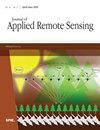基于两阶段无人飞行器深度学习方法的松树枯萎病提取方法
IF 1.4
4区 地球科学
Q4 ENVIRONMENTAL SCIENCES
引用次数: 0
摘要
林业害虫对森林健康构成了重大威胁,因此,精确提取虫害树木是森林保护的一个重要方面。近年来,深度学习在虫害检测方面取得了巨大成功。然而,将现有的深度学习方法应用于虫害树木检测时,会遇到一些挑战,如训练样本有限、林区与人工结构混淆等。为解决这些问题,本研究提出了一种基于无人机可见光图像的两阶段分层半监督深度学习方法,以实现对每种松树枯萎病(PWD)的单独提取。该方法可自动检测每棵受侵染树木的位置和树冠范围。综合框架包括以下关键步骤:(a) 考虑到森林区域和人工结构之间在全局图像表示上的差异,训练一个名为 MobileNetV3 的场景分类网络,以有效区分森林区域和其他人工结构。(b) 考虑到人工标注成本高、出没树木样本标注不完整等问题,引入了一种半监督出没树木样本挖掘方法,大大减少了样本标注的工作量。最终,该方法被集成到 YOLOv7 物体检测网络中,实现了对侵染树的快速、可靠检测。实验结果表明,在置信度阈值为 0.15 的情况下,使用半监督样本挖掘框架,样本数量从 53,046 个增加到 93,544 个。精度评估指标表明,召回率提高了 5.8%,平均平均精度@.5 提高了 2.6%。最终测试区域预测的总体准确率超过了 80%,召回率超过了 90%,这表明所提出的方法在检测公共工程破坏方面非常有效。本文章由计算机程序翻译,如有差异,请以英文原文为准。
Extraction of pine wilt disease based on a two-stage unmanned aerial vehicle deep learning method
Forestry pests pose a significant threat to forest health, making precise extraction of infested trees a vital aspect of forest protection. In recent years, deep learning has achieved substantial success in detecting infestations. However, when applying existing deep learning methods to infested tree detection, challenges arise, such as limited training samples and confusion between forest areas and artificial structures. To address these issues, this work proposes a two-stage hierarchical semi-supervised deep learning approach based on unmanned aerial vehicle visible images to achieve the individual extraction of each pine wilt disease (PWD). The approach can automatically detect the positions and crown extents of each infested tree. The comprehensive framework includes the following key steps: (a) considering the disparities in global image representation between forest areas and artificial structures, a scene classification network named MobileNetV3 is trained to effectively differentiate between forested regions and other artificial structures. (b) Considering the high cost of manually annotating and incomplete labeling of infested tree samples, a semi-supervised infested tree samples mining method is introduced, significantly reducing the workload of sample annotation. Ultimately, this method is integrated into the YOLOv7 object detection network, enabling rapid and reliable detection of infested trees. Experimental results demonstrate that, with a confidence threshold of 0.15 and using the semi-supervised sample mining framework, the number of samples increases from 53,046 to 93,544. Precision evaluation metrics indicate a 5.8% improvement in recall and a 2.6% increase in mean average precision@.5. The final test area prediction achieves an overall accuracy of over 80% and the recall rate of over 90%, indicating the effectiveness of the proposed method in PWD detection.
求助全文
通过发布文献求助,成功后即可免费获取论文全文。
去求助
来源期刊

Journal of Applied Remote Sensing
环境科学-成像科学与照相技术
CiteScore
3.40
自引率
11.80%
发文量
194
审稿时长
3 months
期刊介绍:
The Journal of Applied Remote Sensing is a peer-reviewed journal that optimizes the communication of concepts, information, and progress among the remote sensing community.
 求助内容:
求助内容: 应助结果提醒方式:
应助结果提醒方式:


